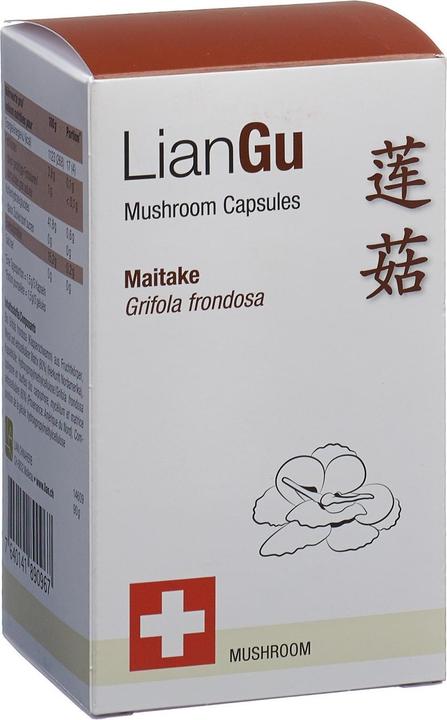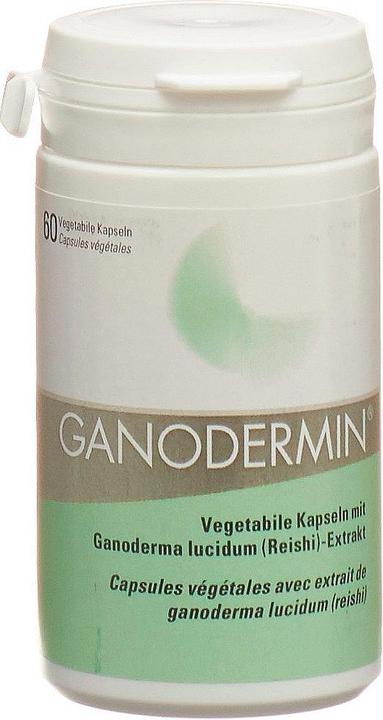

Behind the scenes of Switzerland’s most renowned Asian mushroom producer
If you buy Asian mushrooms in Migros, they’re almost certainly grown by Kernser Edelpilze GmbH. The company’s one of the most renowned Swiss producers of Asian mushrooms. Let me take you on a journey to its underground refrigerator rooms.
Kernser Edelpilze GmbH (website only available in German) is one of Switzerland’s most important producers of a wide range of Asian mushrooms. The company grows around 50 per cent of all Asian mushrooms that are sold in Switzerland – that’s 160 to 180 tons a year – in the Obwalden community of Kerns.
I’m in Kerns to take a look behind the scenes of this company. Like a bright red toadstool, the imposing production site catches my eye from afar. It’s located on a green meadow outside the village, right on the edge of the forest. Underground, however, the site is even larger – just like the mycelium, the root-like structure of a fungus. Managing director and marketing manager Christian Fanger takes me on a tour of the 15 underground refrigerator rooms.
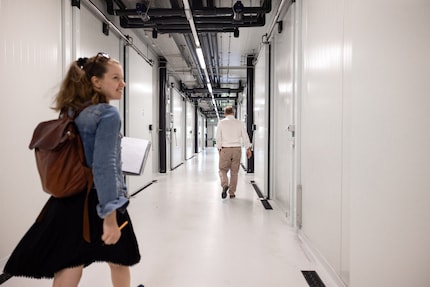
Source: Christian Walker
Arduous growth
We meander through countless corridors like a mushroom mycelium through the earth. At the first junction, I’m sure I’m in a bakery. Are those loaves of bread on the trays? «Looks a bit like bread loaves,» Christian Fanger says with a laugh, «but it’s actually substrates from which the mushrooms will grow.» In other words – their breeding ground. It’s made of wood, recycled grain waste and plant fibres, mycelium, water and gypsum. Each type of mushroom needs its own composition. «It took years of testing to get it right,» Fanger says.
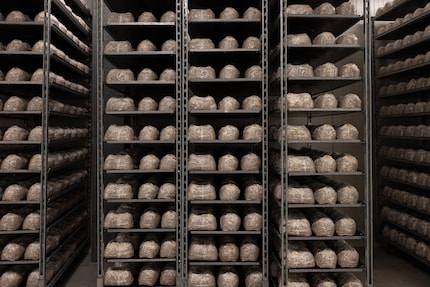
Source: Christian Walker
The economic breeding ground for Asian mushrooms in Switzerland wasn’t fertile for a long time. Nobody knew what they were when the company began growing them in 1995. Not only that, but the German term «Edelpilz» («gourmet mushroom») didn’t even exist. «At the time, Asian mushrooms were called exotic mushrooms – «Exotenpilze» in German. We didn’t think this reflected their high quality. After all, our mushrooms grow on wood and not on compost like button mushrooms. So we introduced the term «Edelpilze» in German. Today, even the European Mushroom Association uses this name,» Fanger explains.
Their name wasn’t the only obstacle. Kernser Edelpilze GmbH needed a permit from the Federal Veterinary Office to cultivate all mushroom species – apart from shiitake, which was already allowed. And obtaining the substrate from abroad wasn’t easy, either. «Giving up wasn’t an option. We always believed in the success of our mushrooms,» Fanger says. In 2011, Kernser Edelpilze GmbH developed an automated substrate machine, making them independent from other countries. This earned the company the agroPrize for innovations in Swiss agriculture in 2014. Large supermarket Migros added the Asian mushrooms to its range and the catering industry also began to show interest. This was the long-awaited breakthrough.
Perfect conditions
We continue winding through the underground corridors until we arrive at a huge sliding door. It’s the entrance to the refrigerator room. Christian Fanger opens the holy gates – I shudder. Not only because the temperature drops to 14 degrees, but because there are mushrooms sprouting everywhere on multi-level rows of racks.
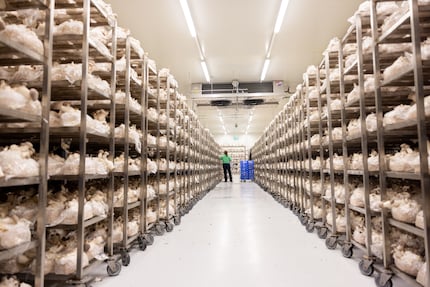
Source: Christian Walker
I don’t know where to look first. At the slippery yellow namekos, the lanky enokis or the massive stems of the king oyster mushrooms? The colours and shapes of these Asian mushrooms are exhilarating.
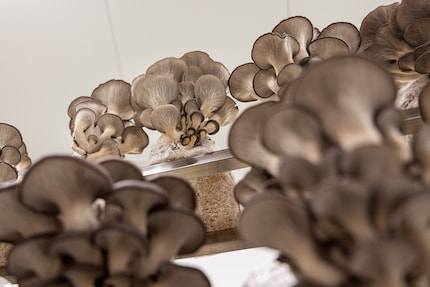
Source: Christian Walker
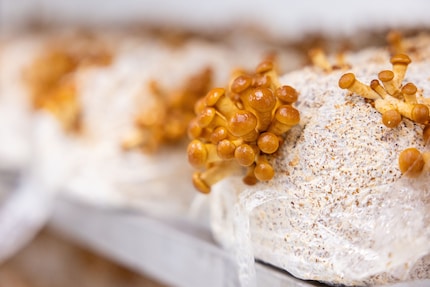
Source: Christian Walker
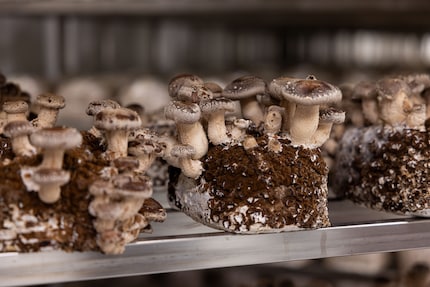
Source: Christian Walker
«That one looks like a Tête de Moine cheese,» I say, pointing to a fluffy white mushroom. «Yes, it’s a pom-pom blanc,» Christian Fanger explains. It does indeed look like a pompom. Christian Fanger shows me how the plastic is cut open as soon as the first mushroom heads peek out of the substrate. You start at the side, which is the easiest to get to. After all, the mushrooms need to be harvested at some point.
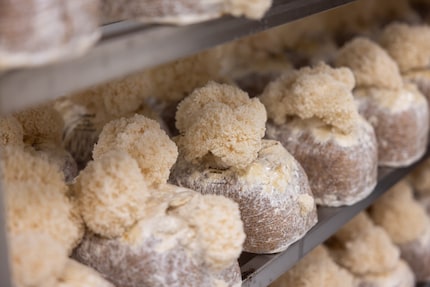
Source: Christian Walker
Depending on the type of mushroom, harvesting time is after four to 15 weeks. The mushrooms on one of the shelves are ready to be harvested. An employee shows us how to cut off the stem of a king oyster mushroom with a knife. Is this assembly line work? Christian Fanger disagrees: «It’s not quite that repetitive. Every mushroom needs to be cut off in a different place. There’s something meditative about it.» Indeed. As I watch the employee glide the knife through the spongy stem, my otherwise noisy mind goes quiet. I could stand here and watch all day – if only it weren’t so cold.
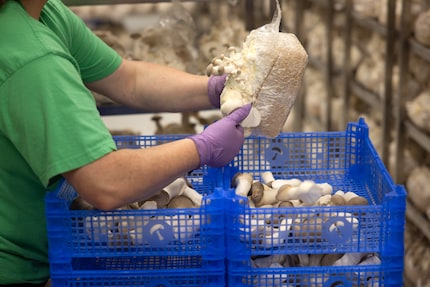
Source: Christian Walker
When a ceiling nebuliser goes off, I shiver even more: «That’s water vapour,» Christian Fanger says and looks up. «Every mushroom needs a different concentration of it. Even tiny changes can have big effects. That’s why we’re in regular contact with our partners in Europe whom we get the mushroom mycelium from.» But even mushroom experts suffer setbacks from time to time. A while ago, for instance, shimeji cultivation was stopped because they wouldn’t grow. Now they’ve started cultivating it again. On the way out, Christian Fanger points to a mushroom that looks like a baby button mushroom. When the sliding door closes behind us, I’m back in my perfect conditions – room temperature.
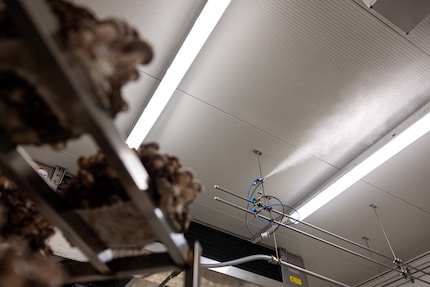
Source: Christian Walker
Far-sighted and visionary
While I’m defrosting, I want to know what happens to the substrate after the mushrooms have been harvested. Christian Fanger takes me to the next room to give me an answer. «The plastic is the only thing we can’t recycle yet. But 85 per cent of the substrate is,» he explains. What’s it turned into? «Potting soil, for example,» Christian Fanger answers, «or animal feed additive for chickens, pigs and calves. In theory, it could also be used as insect food one day if this trend in the food industry continues. We find it important to think and look ahead.»
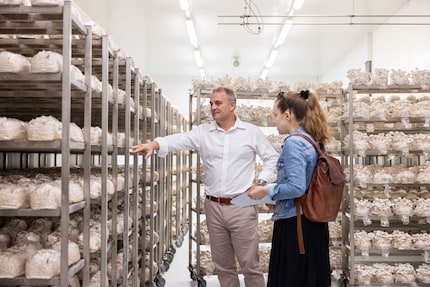
Source: Christian Walker
Looking ahead, quite literally, is best possible from Christian Fanger’s office on the second floor where we take a break. He gazes across the green meadows into the horizon and says: «Our eating habits need to change. In this day and age, it would be important for children to learn about mushrooms. Asian mushrooms should also be served in care homes and used in the pharmaceutical industry.» Chinese medicine, for example, has been using so-called vital mushrooms for thousands of years. They’re said to help strengthen the immune system and fight diseases. The problem in Switzerland is that vital mushrooms are considered food supplements, not medical products. They’re not allowed to be used in Western medicine, as there aren’t any diagnostic studies on the subject yet.
The food sector looks more promising for Asian mushrooms. «With the new climate goalsy, the federal government wants to reduce meat consumption in the next few years. Mushrooms are the perfect substitute,» Christian Fanger says. However, many people in Switzerland are still reluctant to cook with mushrooms. Christian Fanger believes it’s because they don’t prepare them properly. That’s why Kernser Edelpilze GmbH shares recipes on its website. The company also sells dried and pickled Asian mushrooms, mushroom-based condiment and a so-called mushroom factory*, with which you can grow your own shiitake mushrooms at home. On top of this, Kernser Edelpilze GmbH is working on growing new species of mushrooms – the pom-pom blanc that we saw in the refrigerator room, the white enoki and the maitake.
There’s only one mushroom Kernser Edelpilze GmbH will never offer, as Christian Fanger says as he leaves: magic mushrooms.
*Soon, I’ll start experimenting with my own mushroom factory. Follow my profile to see how my shiitake mushrooms sprout over the next few weeks. In theory, it should look like this:[[video:243465]]
What’s the story with you and mushrooms? Which ones are your favourites? And how do you prepare them? I’m looking forward to your comments.
I love anything with four legs or roots - especially my shelter cats Jasper and Joy and my collection of succulents. My favourite things to do are stalking around with police dogs and cat coiffeurs on reportages or letting sensitive stories flourish in garden brockis and Japanese gardens.
Interesting facts about products, behind-the-scenes looks at manufacturers and deep-dives on interesting people.
Show all